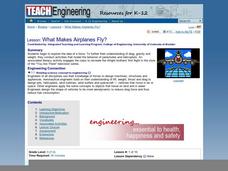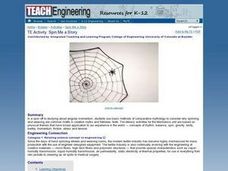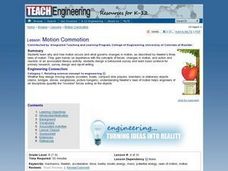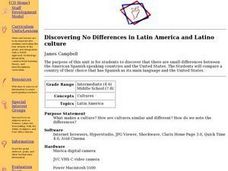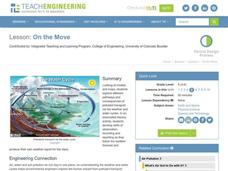Curated OER
Roman Archy
Third graders use Google Earth to examine Roman architecture. In this ancient Rome lesson, 3rd graders visit the noted URLs to look at examples of Roman architecture. Students work in teams to examine data about the structures.
Dr. Seuss Enterprises
Read Across America
Celebrate the whimsical world of Dr. Seuss on Read Across America Day with a collection of science, technology, engineering, the arts, and mathematics activities, each linked to a popular Dr. Seuss story.
Curated OER
Population Biology - Biology Teaching Thesis
Students explore the effects of different density-dependent and density-independent factors on population growth. They explore how the interactions of organisms can affect population growth. Students explore the pattern of population...
Curated OER
Circulation
Learners define the functions of the circulatory system. In this body circulation lesson students see how engineers have involvement with the circulatory system.
Curated OER
What Makes Airplanes Fly?
Students examine force and conduct activities that model parachutes and helicopters. In this airplanes instructional activity students identify the forces that make airplanes fly higher and land.
Curated OER
Playing with Language: Tall Tales and Codes
Pupils interpret and identify the elements of folktales, with an emphasis on tall tales, in this lesson. Students utilize brainstorming techniques to list ways people communicate. Pupils also read and create a time line and present...
Curated OER
Classification: Dichotomous Key
Learners explain the classification process of organisms. In this biology lesson, students practice writing the names of organisms scientifically. They answer the dichotomous key and discuss answers as a class.
Curated OER
Shake, Rattle and Roll
Sixth graders explore the causes and effects of earthquakes. They also collect and analyze data in graphs. They also use the Internet to research earthquakes
Curated OER
Spin Me a Story
Students examine the motif of spinning and weaving in myths and folktales. They read various myths, complete a WebQuest, develop a mind map of story elements, and write an original "spider" story.
Curated OER
Wow! It's A Cow!
Students use the Internet to visit a dairy farm and watch the ins and outs of the every day life of a dairy cow. They survey products that are consumed that come from a cow. The students determine in what states cows would most likely...
Curated OER
Composition
Ninth graders, while looking and examining a photograph provided to them, write a composition that exemplifies the photograph with at least three of the five composition rules illustrated with 100% accuracy. The composition is the start...
Curated OER
The Monarch Butterfly Watch
Learners explore monarch migration through the Journey North web site. In this butterfly instructional activity, students use the internet to identify a butterfly's migration pattern. Learners write in electronic journals.
Curated OER
It's Not Just Story Time... It's Learning Time!
Students look at picture books and describe the story elements. In this picture book lesson, students retell a story and begin to understand the story elements of plot, setting, and characters. Students complete graphic organizers to...
Curated OER
GPS Treasure Hunt for Knowledge
Students examine themselves as being part of a global community. In this global community lesson, students investigate GPS systems. Students gain knowledge on how the device works. Students discover that satellites provide information...
Curated OER
Monitoring an Epidemic: Analyzing Through Graphical Displays Factors Relating to the Spread of HIV/AIDS
Tenth graders differentiate pandemic and epidemic. In this health science lesson plan, 10th graders analyze how HIV and AIDS affect different countries. They construct and interpret different types of graphs.
Curated OER
Science: Motion Commotion
Learners examine Newton's three laws of motion to discover what causes it and how it changes. They conduct motion experiments by building catapults and constructing balloon rockets. Finally, they conduct peer studies correlating...
Curated OER
Dots
Students read the story "Ten Black Dots." They brainstorm what you can do with dots. Students create a picture and a story with ten dots. They discuss how a computer uses dots. Additional ideas are listed for cross curriculum.
Curated OER
Social Studies: Aztec Calendars and Culture
Sixth graders analyze the Aztec calendar and create their own examples of them. They determine the meaning of the symbols used in the calendars and record their ideas in journals. Students host a parent breakfast for them to observe...
T. Smith Publishing
Pretty Pink and Purple Pigs
Perfect pigs dance across this handout. On it, little learners choose two to color pink, and one to color purple. Two will remain uncolored. This is an appropriate exercise in color recognition and following directions.
Curated OER
Presidents
Students identify the qualities needed to become President of the United States. Using the internet, they discover the differences in character of past presidents and draw conclusions about their time in office. They relate a piece of...
Curated OER
Discovering No Differences in Latin America and Latino Culture
Students explore the differences between American Spanish speaking countries and the United States. Students explore the history and culture of Spanish speaking countries. They examine Latino influences. Students create a presentation...
T. Smith Publishing
Solar System Fun
Looking for some vocabulary for your unit on space? Check out this 25-word solar system crossword puzzle for ideas. There is no word bank for this puzzle, so pupils will either need prior instruction or a reference material that they can...
Curated OER
Riding the Gravity Wave
Students write a sketch of an artist or athlete that has pushed the limits on gravity. They explore concepts of rhythm, balance and friction. They examine how engineers design sports equipment.
Curated OER
On the Move
Students explore different pathways and consequences of pollutant transport via the weather and water cycles. They observe and record weather information and produce their own weather report for the class.






